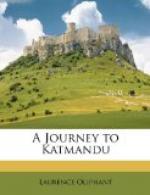By the exertions of these city police we reached Cashmere Mull’s house, noted as a specimen of antique Oriental architecture.
The court-yard into which we were first ushered reminded me of an old English “hostelrie;” it was small and uncovered, and round each story ran a curiously worked balcony, on to which opened doors and windows, carved with strange devices, and all the nooks and crannies formed by so much intricate carving were filled with dust and cobwebs. Passing up a narrow, dark, and steep stone stair, we reached a second court-yard, upon the balcony of which we emerged, and which was so very like the last, that I imagined it to be the same, until I remarked that it was smaller, and, if possible, more dirty. We thence ascended to the flat roof of the house, and on our way looked through half-open doors into dark dungeons of rooms, which one would not for the world have ventured into at night.
There was a raised stage with steps up to it, which we ascended and found ourselves on a level with a great many similar stages on the tops of a great many similar houses. A stone parapet about 8 feet high, with beautiful open carving, enclosed this stage, so that we could inspect our neighbours through our stone screen with impunity. On the next roof to where we were was a boy training pigeons, and the numerous crates or frames on the surrounding house-tops showed this to be a favourite amusement. The young gentleman in question certainly made his flock obey him in a wonderful manner, his chief object being to take prisoner a pigeon from his neighbour’s flock. He directed their gyrations by loud shrill cries, and, as there were numbers of other members of “Young Benares” employed in like manner, it seemed wonderful how he could recognize his pigeons, or they their master.
Leaving this antique specimen of a nobleman’s town house, we passed through a maze of narrow streets; and bobbing under low archways at the imminent peril of fracturing our skulls, we arrived at the Bisheshwan Temple, which was crowded with Hindoos worshipping the Lingum, representations of which met the eye in every direction.
A well in the yard behind the temple was surrounded by worshippers of the god, who is supposed to have plunged down it and never to have come up again. If so, he must find the smell of decayed vegetation very oppressive, as garlands of flowers and handfuls of rice are continually being offered up, or rather down, to him. From this well we had a good view of the temple, which was covered with gold by Runjeet Singh, and presents a gorgeous and dazzling appearance.




